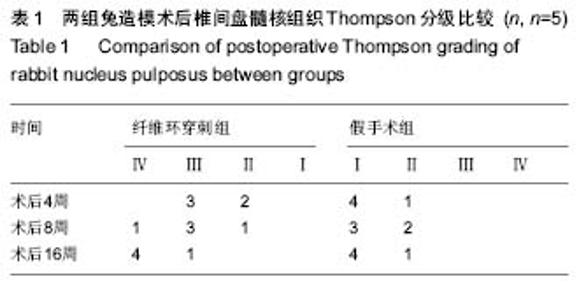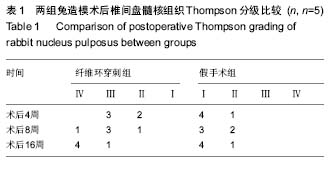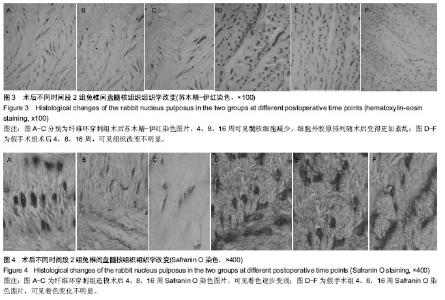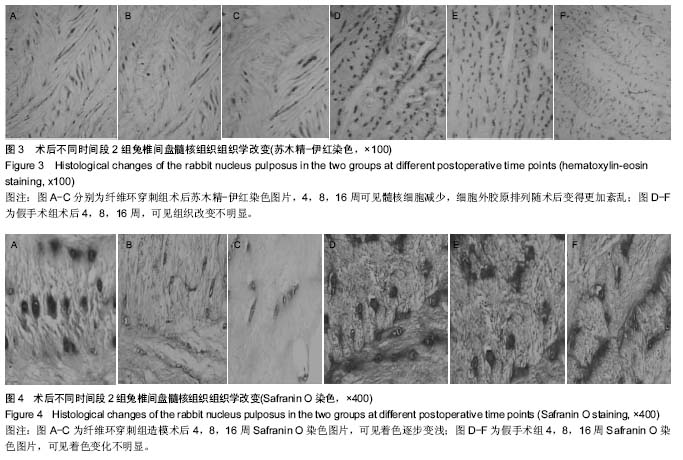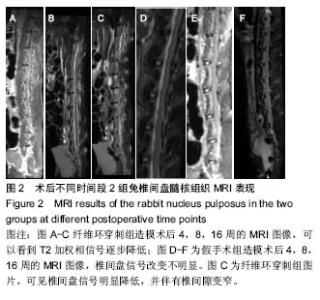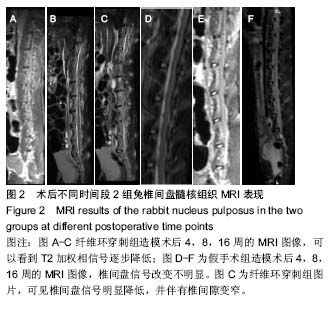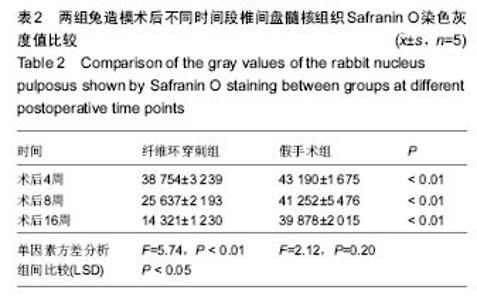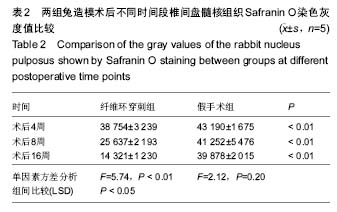| [1] Freemont AJ. The cellular pathobiology of the degenerate intervertebral disc and discogenic back pain. Rheumatology (Oxford). 2009;48:5-10.[2] Masuda K. Biological repair of the degenerated intervertebral disc by the injection of growth factors. Eur Spine J. 2008;17 Suppl 4: 441-451. [3] Masuda K, An HS. Growth factors and the intervertebral disc.Spine J. 2004;4(6 Suppl):330S-340S. [4] 谭伟伟,何升华,孙志涛,等.微创针刺旋切制备兔椎间盘退变模型[J].中国修复重建外科杂志,2016,3(30):343-347.[5] 崔运能,李绍林,周荣平, 等.CT引导下经皮纤维环穿刺建立兔腰椎间盘退变模型[J]. 中国脊柱脊髓杂志,2016,24(3): 234-243.[6] Issy AC, Castania V, Castania M, et al. Experimental model of intervertebral disc degeneration by needle puncture in Wistar rats. Braz J Med Biol Res. 2013;46(3):235-244.[7] 王珏,张雷,刘杨青,等.经皮微创纤维环穿刺法制作兔椎间盘退变模型[J]. 第三军医大学学报,2013,35(15):1579-1582.[8] 邵辉,卞正君,孙建华.纤维环穿刺髓核抽吸法建立兔椎间盘退变模型[J].石河子大学学报,2015,33(1):97-101.[9] 白亦光,韩小伟,张旭乾,等.纤维环穿刺抽吸法和纤维环切开法建立兔椎间盘退变模型的比较[J].中国矫形外科杂志,2013, 21(7):679-694.[10] 罗平,刘玉林,陈仲,等. 纤维环穿刺法与纤维环切开法建立兔椎间盘退变模型[J].中国组织工程研究与临床康复,2010, 11(14):1955-1958.[11] 杨效宁,孙天威,王启明,等. 纤维环穿刺法诱导兔椎间盘退变模型的组织学和影像学分析[J]. 徐州医学院学报,2010, 30(5):314-317.[12] 吴剑宏,阮狄克.腰椎间盘退变的MRI诊断分级及其临床应用进展[J].中国脊柱脊髓杂志,2010,20(6):511-513.[13] Silberberg R. The vertebral column of diabetic sand rats (psammomys obesus). Exp Cell Biol. 1988;56(4): 217-220. [14] 吴靖平,陈统一,陈中伟,等.双后肢大鼠椎间盘退变动物模型的建立[J].中华实验外科杂志, 2004, 21(1): 105-107.[15] Clouel J, Pot-Vaucel M, Grimandi G, et al. Characterization of the age-dependent intervertebral disc changes in rabbit by correlation between MRI, histology and gene expression. BMC Musculoskelet Disorrl. 2011;12: 147.[16] Lotz JC. Animal models of intervertebral disc degeneration: Lessons learned. Spine. 2004;29(23): 2742-2750.[17] Kroeber MW, Unglaub F, Wang H, et al. New in vivo animal model to create intervertebral disc degeneration and toinvestigate the effects of therapeutic strategies to stimulate disc regeneration. Spine. 2002;27(23): 2684-2690.[18] 熊蠡茗,邵增务,郭兵,等.可控轴向压力致兔腰椎间盘退变模型的建立及评价[J].中国矫形外科杂志, 2009, 17(19):1492- 1496.[19] 黄宗强,刘尚礼,郑召民.双侧关节突关节切除诱发椎间盘退变的磁共振计量分析[J].中国矫形外科杂志, 2007, 15(15): 1175-1177.[20] Imai Y, Okuma M, An HS et al. Restoration of disc height loss by recombinant human osteogenic protein-1 injection into intervertebral discs undergoing degeneration induced by an intradiscal injection of chondroitinase ABC. Spine. 2007;32(11): 1197-1205.[21] Radcliff KE, Kepler CK, Jakoi A,et al. Adjacent segment disease in the lumbar spine following different treatment interventions. Spine J. 2013;13(10): 1339-1349.[22] Kepler CK, Ponnappan RK, Tannoury CA,et al. The molecular basis of intervertebral disc degeneration.Spine J.2013;13(3): 318-330.[23] Cho H,Lee S,Park SH,et al. Synergistic effect of combined growth factors in porcine intervertebral disc degeneration. Connect Tissue Res. 2013;54(3):181-186.[24] Lee H, Sowa G, Vo N, et al. Effect of bupivacaine on intervertebral disc cell viability.Spine J. 2010;10(2):159-166.[25] Haschtmann D,Stoyanov JV,Gedet P,et al. Vertebral endplate trauma induces disc cell apoptosis and promotes organ degeneration in vitro. Eur Spine J. 2008;17(2): 289-299.[26] Sun W, Zhang K, Liu G, et al. Sox9 gene transfer enhanced regenerative effect of bone marrow mesenchymal stem cells on the degenerated intervertebral disc in a rabbit model. PLoS One. 2014;9(4):e93570.[27] Xia X, Guo J, Lu F, et al. SIRT1 plays a protective role in intervertebral disc degeneration in a puncture induced rodent model. Spine(Phila Pa1976). 2015;40(9): E515-E524.[28] 江立波,张小磊,徐华梓,等.细胞自噬对饥饿环境下椎间盘髓 核细胞的保护作用[J].中国病理生理杂志,2012,28(7):1302- 1307.[29] 郑旭浩,张小磊,江立波,等.细胞自噬在糖尿病大鼠椎间盘退变中的作用[J]. 中国病理生理杂志,2013,29(11):2011-2016.[30] 杜炎鑫,佟德民,邓晋丰,等.纤维环穿刺法建立兔腰椎间盘退变模型[J]. 宁夏医科大学学报,2013,5(20):132-135.[31] Sobajima S, Kompel JF, Kim JS, et al. A slowly progressive and reproducible animal model of intervertebral disc degeneration characterized by MRI, X-ray, and histology. Spine (Phila Pa 1976). 2005;30(1): 15-24.[32] 黑龙,张佳林,李宏辉,等.经皮纤维环穿刺和纤维环切开法建立兔椎间盘退变模型的比较[J].宁夏医科大学学报,2015,37(11): 1279-1282.[33] Sobajima S, Kompel JF, Kim JS, et al. A slowly progressive andreproducible animal model of intervertebral disc degeneration characterized by MRI, X- ray, and histology. Spine. 2005;30(1): 15-24.[34] 王诗军,李淳德,孙浩林,等.针刺损伤兔椎间盘退变模型组织病理变化及软骨样细胞的迁移规律[J].中国组织工程研究与临床康复,2012,9 (16):1597-1600.[35] Longo UGL, Ripalda P, Denaro V, et al. Morphologic comparison of cervical, thoracic, lumbar intervertebral discs of cynomolgus monkey (Macaca fascicularis). Eur Spine J.2006;15(12): 1845-1851. |
